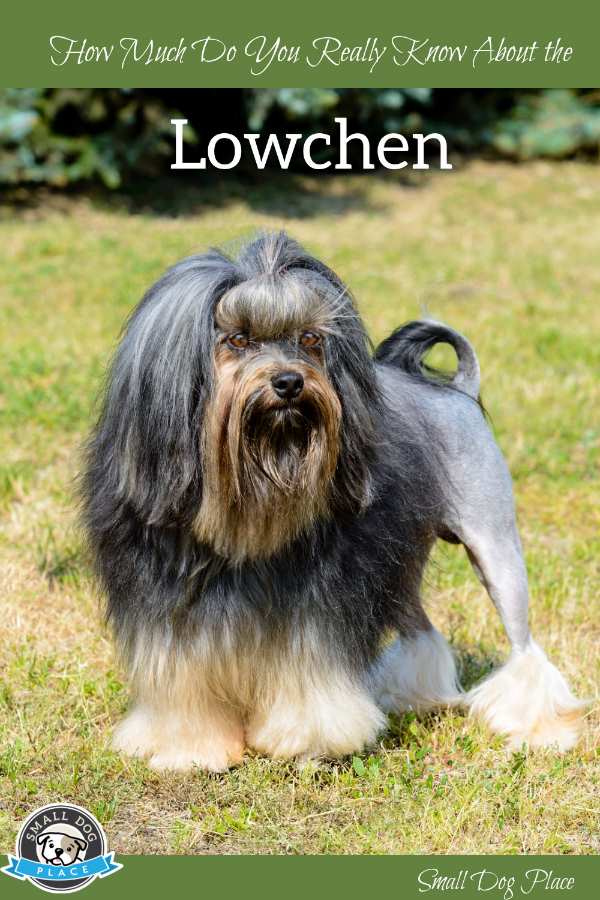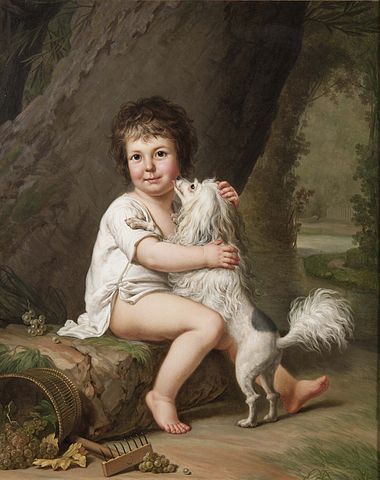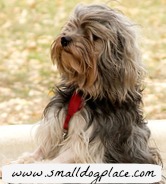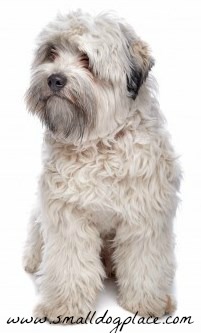The Lowchen: Rare & Beautiful
by Janice Jones |Last updated 09-02-2021
The Lowchen or “little lion” gets its name from the distinct show trim that resembles a lion. You will recognize immediately the look of the lion in this dog when trimmed:
The coat hair is left natural and untrimmed on the forequarters and clipped close to the skin on the hindquarters with little cuffs of hair around the ankles and a small plume on the tail.
Does clipping a dog in this way make it seem bigger than life? Well some Löwchen, even though they are a small breed, think they are much bigger.
But the distinctive look is not really the reason people fall in love
with this breed. They are intelligent,
affectionate, lively and outgoing.

| Traits | Rating |
|---|---|
| Playfulness | |
| Affection Level | |
| Friendliness Towards Strangers | |
| Good with Children | |
| Good with Other Dogs | |
| Good for First Time Owners | |
| Exercise Needed | |
| Ease of Training | |
| Watch Dog Ability | |
| Grooming Requirements | |
| Shedding | |
| Cold Tolerant | |
| Heat Tolerant |
Explanations for At a Glance Ratings
- Playfulness: Most=5 Less=1
- Affection: Most=5 Least=1
- Friendliness Towards Strangers: Most=5 Least=1
- Good with Children: Good=5 Not Good=1
- Good with Other Dogs: Good=5 Not Good=1
- Good for First Time Owners: Good=5 Not Good=1
- Amount of Exercise Required: Much=5 Minimal=1
- Ease of Training: Easy=5 Difficult=1
- Watch Dog Ability: Excellent=5 Poor=1
- Grooming Needs: Extensive=5 Minimal=1
- Shedding: Heavy Shedding=5 Minimal Shedding=1
- Cold Tolerance: Cold Well Tolerated=5 Poorly Tolerated=1
- Heat Tolerance: Heat Well Tolerated=5 Poorly Tolerated=1
Did I mention that they are one of the healthier breeds? Great health along with active, playful personality might make this the perfect companion for families, couples or singles. They do great with children and excel in agility and obedience.
This breed is usually fine with people who suffer from allergies. There is little dander, and the Lowchen has hair, like humans and not fur. They do loose hairs, a few at a time, but are not considered a breed that sheds. Regular brushing removes loose hair so your furniture will not be covered with it when a Lowchen gets up from a nap.
The Löwchen does not need excessive exercise but does enjoy a daily walk. Most of his exercise needs can be met usually as he follows you from room to room or during a brisk play session indoors or out.
Quick Facts
Other Names Used: Little Lion, Little Lion Dog, Petit Chien Lion
Affiliation: AKC Non-Sporting
Size
Height: 12 to 13 inches at the Shoulders
Weight: 9 to 20 pounds
Coat Type
Colors: All Colors and color combinations including Black, Silver, Tan, Brindle, Blue, Chocolate, Cream, Fawn, Gold, Sable, Red, White
Country of Origin: Disputed: Europe
Activity Level: Moderately active
Life Expectancy: 12-15 years
Good with Children: Yes
Good with other pets: Yes
History of the Lowchen

Portrait
of the young Henri Bertholet-Campan (1784-1821)
with the dog Aline
Courtesy Creative Commons
We know that Lowchen history can be traced back to the 16th century because they are well represented in period paintings, tapestries, wood carvings, and drawings. Artwork shows the breed sporting the lion-trim, so it is possible that this grooming style was being used early on.
The Lowchen breed began in Europe, and is thought to be related to the Bichon and Havanese, though the exact origins of the breed remain obscure. Theory has it that they were brought to Europe by travelers from the Far East especially Tibet. Once in Europe they mingled with local Spitz and terrier type dogs.
They were companion dogs to the wealthy and elite ladies of the court and often served as foot warmers and comforters.
Belgium, France, Germany and Russia all claim to be the country of origin of the breed, though a dog which surprisingly resembled a Löwchen in a lion-trim was depicted in the 16th century German painting.
Maltese Lion Dog has been dubbed the earliest name given to the breed until it was renamed Bichon Petit Chien Lion by a French naturalist. Since then, the French has determined that they were the country of origin. The breed seemed to be very popular during its early history, but for unknown reasons, eventually grew rarer and rarer over time.
A Löwchen fancier named Madame Bennert of Brussels is credited with saving the breed through her extensive breeding efforts that began right after World War II. She wanted to save the breed, so she found two females and one male and later located another female.
All current Löwchen dogs can be traced to these roots. Soon after, the breed’s numbers began to increase, and during the late 1960s and early 1970s, the breed was finally introduced to Great Britain in 1968. The United States saw their first members of the breed in 1971, and then to Canada and Australia. The Guinness Book of Records listed the breed as the rarest breed in the late 1960s.
By 1996, the Lowchen was received into the AKC Miscellaneous class and then recognized in the Non-Sporting Group in 1999.
Personality
 Lowchen
LowchenSomeone forgot to tell the Löwchen that he is a small dog because he thinks of himself as a BIG dog. They make devoted companions and do well with children in the household as well as other pets. Children should be taught how to treat a dog gently, and as with any small breed dog, not child should be allowed to tease or torment them.
Some call them clowns, so if entertainment is what you are looking for, this might be a great breed for you. There is never a dull moment—they will let you know what the neighbors are doing, when a squirrel runs up a tree or just in case, you’re not paying attention, they will announce themselves, so you won’t forget they are around. They are not a breed to be ignored.
They are bright and easy to train and make great watch dogs. They excel in agility and Fly Ball due to their great athletic abilities. Water sports may be an option if you end up with a Lowchen that likes the water. Not all love water, though.
They are still aver relatively rare breed, to getting one might be a problem. You are likely to pay more for a rare breed than one that is very popular and easily obtainable.
Grooming

The Löwchen has a relatively distinct coat. Although they grow a single coat that grows long all over, it is composed of heavier guard hairs and finer undercoat. The traditional lion-clip is what distinguishes it from other long hair breeds.
Many people think that the dogs just “come that way.” Nope, they need to be shaved to achieve that Lion Dog Look. Normally, the dog is shaved down to the first rib, leaving the hair natural on the rest of the dog.
While the Lion Clip is used on show dogs, non-show dog owners often choose to keep them in a puppy cut that is easier to maintain. For pet owners, puppy trim can be maintained by professional grooming approximately every 2 months.
For a Lion Clip, the hindquarters are shaved; one-half of the tail closest to the body is clipped leaving a plume in the end, and the feet are trimmed just like that seen in the poodle.
The legs are trimmed leaving a cuff or hair from the elbows to the feet. The front legs are clipped except for the cuff of hair and the body hair on the shoulders which is left long and flowing over the legs.
Besides the trims, their thick coats need to be brushed regularly to keep mats from forming. Toenails will need to be trimmed, teeth brushed, and the dog bathed occasionally.
Health Concerns
The Löwchen is a healthy breed with few specific genetic problems. On average, they can live to be 15 years old.
But as with all dog breeds, aging can bring on problems such as cataracts or congenital heart disease.
Cushing ’s disease has
also been identified in older members of this breed. Cushing’s disease or syndrome occurs when cortisone
increases in the system usually due to a benign pituitary tumor.
Teeth Problems:
Some puppies have long roots on their deciduous teeth making them
difficult to fall out naturally.
Sometimes the baby teeth need to be pulled so the permanent teeth can
erupt. This is usually not a problem as
most vets will examine the mouth during the time of spay or neuter and remove
any remaining baby teeth.
Although rare certain other conditions have been identified:
PRA (progressive retinal atrophy)
Pros
- Alert, Intelligent
- Easy to Train
- Friendly
- Great Family Dog; Good with Children & Other Pets
- Athletic
- Good Watch Dog
Cons
- Requires much grooming
- Can be a barker
- Very rare: Difficult to find
- May be Expensive
Did You Know?
- Freeway, an unclipped Löwchen, was featured on the popular television show, Hart to Hart.
- The breed club chose to keep the long tradition of the lion trim, even though many would prefer to let the dogs remained unclipped.
Breed Club
Pin for Future Reference

About Janice (author and voice behind this site)
Having lived with dogs and cats most of her life, Janice served as a veterinary technician for ten years in Maryland and twelve years as a Shih Tzu dog breeder in Ohio.
Her education includes undergraduate degrees in Psychology with a minor in biology, Early Childhood Education, and Nursing, and a master's in Mental Health Counseling.
She is a lifelong learner, a dog lover, and passionate about the welfare of animals. Her favorite breed for over 50 years has been the Shih Tzu, but she has also lived with Poodles, Maltese, Yorkshire Terriers, Beagles, English Bulldogs, Carin Terriers, and a Cocker Spaniel.
When not writing, reading, and researching dog-related topics, she likes to spend time with her eight Shih Tzu dogs, husband, and family, as well as knitting and crocheting. She is also the voice behind Miracle Shih Tzu and Smart-Knit-Crocheting
Does This Article Deserve Your Thumbs Up?
We always appreciate your support and encouragement. Your thumbs up means so much to us. Please like this article.
If you find this page or any page on Small Dog Place Helpful, or useful in anyway, I'd love it if you would click the small heart found on the bottom right of each page.
You can also share or bookmark this page -- just click on the:

Free Monthly Newsletter
Sign Up for Our Free Newsletter and get our Free Gift to You.
my E-book, The Top 10 Mistakes People Make When Choosing a Dog (and how to avoid them)

